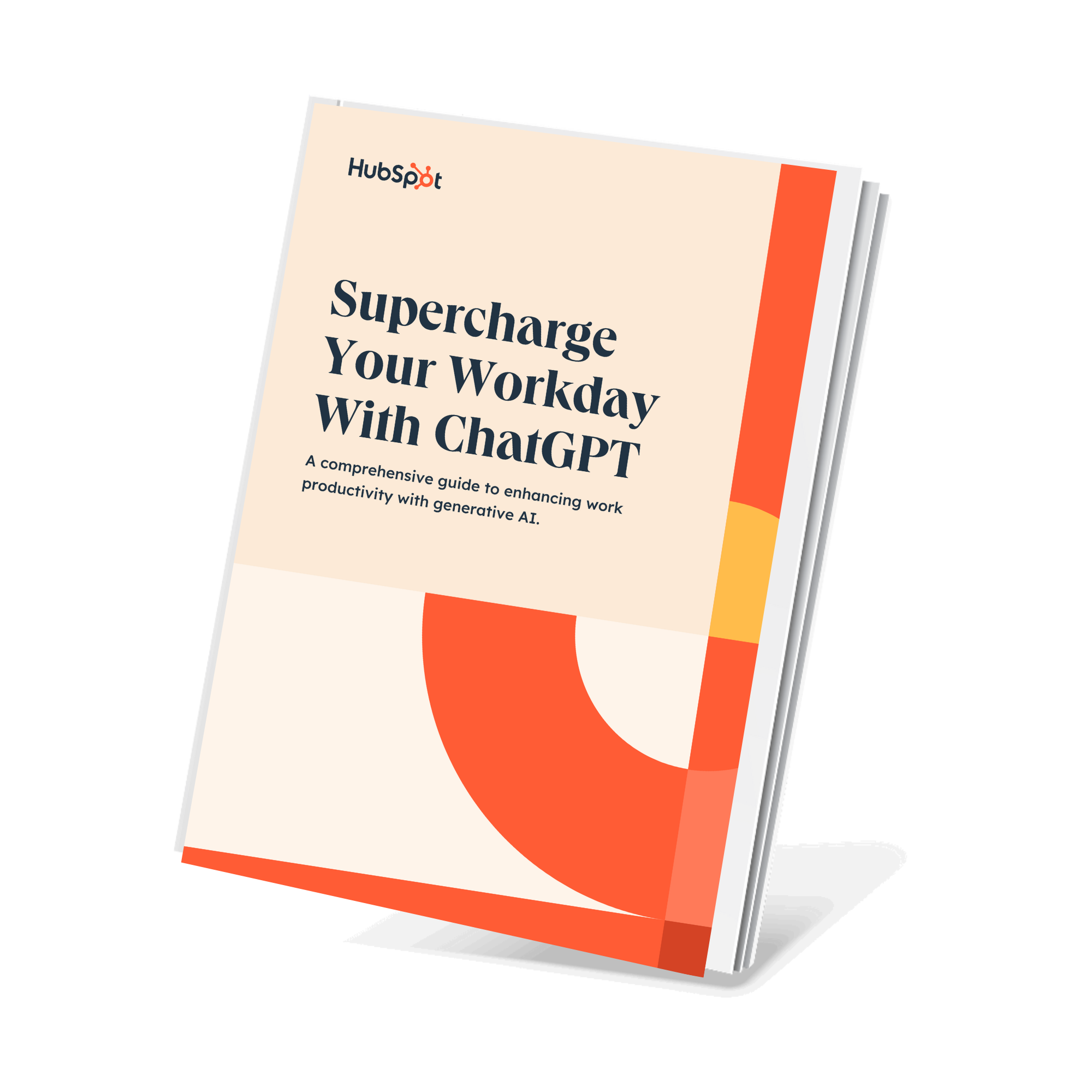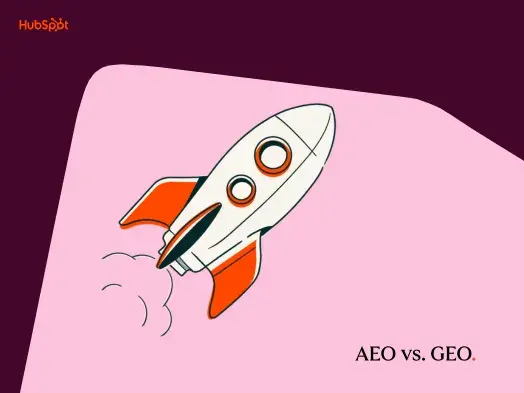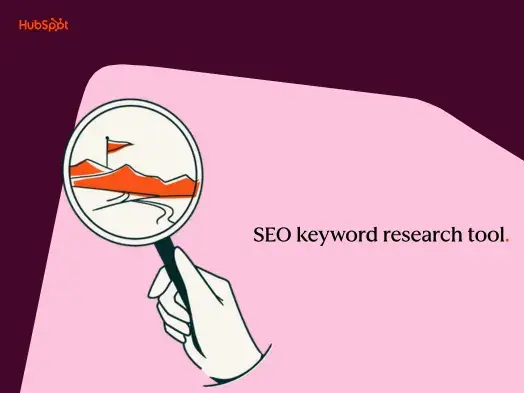SEO is transforming. AI search queries now average 23 words compared to Google's 4-word standard, and platforms like ChatGPT and Perplexity are reshaping how 200+ million users find information online. This shift demands a new approach: generative SEO (also known as generative engine optimization or GEO).
The good news? You don't need to abandon your SEO expertise. Generative SEO builds on proven principles while introducing new techniques for AI visibility. This guide shows you exactly how to optimize content for both traditional and AI-driven search engines, with actionable strategies you can implement today.
If you‘re ready to harness AI for your marketing efforts, start with HubSpot’s comprehensive guide to using ChatGPT for work, which includes over 100 proven prompts for marketers, sales teams, and content creators.
Table of Contents
- What is generative engine optimization?
- GEO vs. SEO
- Why is GEO important?
- How does generative engine optimization work?
- How to Implement Generative SEO Strategies for Your Business
- Best Practices for Optimizing Content for Different AI Search Engines
- Common Mistakes to Avoid with Generative SEO
- GEO Content Structure Guidelines with Specific Examples
- Measurement & Tracking the Success of GEO Efforts
- Generative Engine Optimization FAQ
Unlike traditional SEO, which focuses on ranking high in search engine results pages (SERPs), generative SEO optimizes content to be cited, referenced, and synthesized by AI engines like ChatGPT, Perplexity, Claude, and Google AI Overviews.
Traditional SEO focuses on ranking in keyword-based search engine results, while generative SEO differs from traditional SEO by prioritizing natural language queries and authoritative answers. AI search engines use large language models to generate conversational search results that synthesize information from multiple sources into coherent, context-rich responses.
Generative engines work by:
- Interpreting conversational user queries (averaging 23 words vs. Google's 4)
- Leveraging personal data and conversation history for context
- Searching across multiple sources for relevant information
- Synthesizing findings into comprehensive, narrative responses
- Providing citations and source links for verification

GEO vs. SEO
While generative SEO (GEO) and traditional SEO share foundational principles, they diverge in crucial ways. Understanding both similarities and differences helps you optimize for all search environments.
How is GEO similar to SEO?
Both GEO and SEO share four core principles that make your existing expertise valuable:
1. Both provide user-first content.
Both prioritize helpful, accurate information that directly answers user queries. Whether you’re searching on Google, Bing, ChatGPT, Perplexity, or something else entirely, what’s essential is that you can access the information you need in the easiest and shortest time possible.
One reason Google is so successful is that it has mastered a complex (and ever-changing) algorithm that sorts through content and delivers the best possible result to the person searching. Results meet search intent, and users get what they want.
Why this matters for GEO: If you’re dedicated to providing the best possible content, you have a good chance of gaining visibility in generative AI search engines. These tools need to source the best content to keep users returning.
2. E-E-A-T signals matter for both GEO and SEO.
Experience, expertise, authoritativeness, and trustworthiness remain crucial. When HubSpot ranks #3 for “CRM” on Google, it also appears as ChatGPT's top CRM recommendation — proving E-E-A-T transfers across platforms.
To demonstrate how E-E-A-T is important for GEO and SEO, let me lead with an example.If you search “CRM” in Google, you’ll see that HubSpot’s is ranked page one, rank three in the U.S.
.webp?width=650&height=513&name=generative-engine-optimization-2-20250530-9197061%20(1).webp)
I searched ChatGPT to see if HubSpot is recommended as a CRM. It is. HubSpot is the top recommendation in ChatGPT.
.webp?width=650&height=571&name=generative-engine-optimization-3-20250530-7189322%20(1).webp)
3. Keywords still provide context.
While AI queries use more natural language, keywords help both traditional and AI engines understand your content's relevance. The difference lies in implementation, not importance.
Chris Long, VP of marketing at Go Fish Digital, has done some testing on visibility in GEO, and his testing suggested that generative search engines do pull clear snippets. Long found success using bullet points.
In a LinkedIn post, he said, “In the past 6 months, we‘ve been doing a lot of testing around optimizing our brand for generative engine optimization. We’ve noticed how AI-driven search tends to pull in content that's extremely structured via bulleted lists, structured headings, and general listicle-style articles.”
Why this matters for GEO: If you’re dedicated to more visibility in generative AI search engines, it could be worth exploring page structure and seeing if it makes a difference.
Top tip: If you want to benchmark your current visibility in generative search engines, you could use HubSpot’s AI Search Grader. It shows you:
- Your brand's visibility and presence in AI.
- Strengths and weaknesses.
- Share of voice.
- And more.
The video below demonstrates how it works.
4. Technical optimization requirements. Fast load times, mobile responsiveness, and crawlability benefit both GEO and SEO. AI engines need to access and parse your content just like traditional crawlers, so webpage performance is just as crucial for one and the other.
How is GEO different from SEO?
The distinctions between GEO and SEO reveal why you need platform-specific strategies:
|
Aspect |
Traditional SEO |
Generative SEO (GEO) |
|
Primary Goal |
Rank high in SERPs |
Appear in AI-generated answers |
|
Output Format |
List of blue links |
Synthesized narrative response |
|
Optimization Focus |
Keywords, backlinks, page authority |
Structure, clarity, citation-worthiness |
|
User Queries |
Short (avg. 4 words) |
Conversational (avg. 23 words) |
|
Success Metrics |
Rankings, CTR, traffic |
Citations, brand mentions, conversions |
|
Content Structure |
Keyword-focused paragraphs |
Scannable lists and hierarchies |
|
Authority Signals |
Backlinks and domain authority |
Expert quotes and original research |
Key technical differences:
- Multi-platform optimization: Different AI engines (ChatGPT, Claude, Perplexity) may favor different content formats and sources.
- Citation potential: Unlike SEO's focus on attracting clicks, GEO optimizes for being cited within AI responses.
- Content structure emphasis: AI engines favor bullet points, numbered lists, and clear hierarchies that enable easy information extraction.

How is GEO impacting SEO?
SEO experts worldwide cite generative AI as the number one disruptor to traditional search. Here‘s what’s changing:
Local search remains stable.
“Local SEO remains largely unaffected. When searching for a plumber or a dentist, they still need results tied to maps, reviews, and real-world proximity,” says SEO expert Nick Baird.
Informational queries see reduced clicks.
Top-funnel content suffers most. “Click-through rates are down in places where AI can summarize quickly. For websites that rely on traffic from listicles or how-to content, traffic is definitely thinner,” Baird explains.
Quality still drives engagement.
“People still click through when they want depth or to verify that a source actually said what the AI is reporting. So while the volume of clicks may be down, it's still important to have quality content on one's website.”
Conversion quality improves.
Nate Tower, president at Perrill, reports that while conversion volume from AI platforms remains lower, conversion rates are notably higher — suggesting users arriving from AI searches have stronger intent.
Why is GEO important?
The shift to AI-driven search represents a fundamental disruption to the $80+ billion SEO industry. With Apple integrating Perplexity and Claude into Safari, Google's distribution monopoly faces its first real challenge in decades.
Key Benefits of GEO
1. Access to high-intent users. AI search users demonstrate stronger purchase intent. They ask detailed questions and expect comprehensive answers, leading to higher conversion rates despite lower traffic volumes.
2. First-mover advantage. While most brands focus on traditional SEO, early GEO adopters can establish authority in AI search results before competition intensifies.
3. Future-proof visibility. ChatGPT serves 800+ million weekly users, with rapid growth across all AI platforms. Optimizing now positions you for the inevitable shift in search behavior.
4. Enhanced brand credibility. Being cited by AI engines acts as a third-party endorsement, building trust faster than traditional search rankings.
5. Subscription economy alignment. Unlike ad-driven traditional search, AI platforms use subscription models. This creates opportunities for deeper, more valuable content without competing against ads.
The Data Behind GEO's Importance
Nate Tower goes onto share compelling evidence: “Conversions, by percentage, from LLMs are higher. People chat with AI and see the software more as a friend, which is one reason why conversions from GEO are higher.”
While conversion volumes remain lower than traditional search, the quality signals a shift in user behavior. AI search users:
- Spend 6 minutes per session (vs. seconds on Google)
- Ask follow-up questions to refine their needs
- Trust AI recommendations more readily
This behavioral shift means that even with smaller audiences, GEO can deliver significant business impact for prepared brands.
How does generative engine optimization work?
Generative SEO requires platform-specific optimization strategies for engines like ChatGPT, Perplexity, and Google AI Overviews. Each platform has unique preferences for content structure, source credibility, and information formatting.
Core GEO principles:
- Clear, scannable structure: Use headers, bullet points, and numbered lists that AI can easily parse
- Authoritative sources: Include expert quotes, statistics, and credible citations
- Natural language optimization: Write conversationally while maintaining professional authority
- Citation-worthy content: Create information that AI engines want to reference and link to
Platform-specific considerations:
- ChatGPT: Favors comprehensive, well-sourced content with clear expertise signals
- Perplexity: Excels at citation, making source credibility paramount
- Google AI Overviews: Integrates traditional ranking factors with AI synthesis capabilities
The key difference from traditional SEO is that you're optimizing for synthesis rather than ranking. Your content needs to be easily extractable, quotable, and combinable with information from other sources. Check out other best practices when it comes to SEO — as many of them overlap with GEO best practices.
If your content is high quality, you shouldn’t experience any sort of penalty for leveraging AI content tools, like the ones offered by HubSpot.

How to Implement Generative SEO Strategies for Your Business
1. Manage your brand narrative.
As generative engines pull information directly from web content, whatever exists online about your brand shapes AI recommendations. Unlike traditional SEO where you compete for clicks, GEO requires consistent messaging across all digital touchpoints.
Action steps:
- Audit current brand mentions across platforms
- Develop clear positioning statements for key products/services
- Create FAQ content addressing common queries
- Monitor how AI engines currently describe your brand
Example approach: Think about your unique value proposition:
- What specific problems do you solve?
- Who is your ideal customer?
- What makes your solution different?
In generative search, products are recommended with specific rationales. Ensure your content clearly articulates why someone should choose your solution over alternatives.
2. Conduct AI-focused keyword research.
Traditional keyword research remains valuable, but GEO requires understanding how people phrase conversational queries. AI search optimization demands targeting longer, question-based phrases that reflect natural speech patterns.
Research process:
- Identify keywords that trigger AI overviews in Google
- Analyze question-based queries related to your expertise
- Map conversational versions of your core keywords
- Use tools like AlsoAsked to understand related questions
Implementation strategy:
- Lead with one focus keyword per page
- Develop keyword clusters including natural language variations
- Target specific question patterns your audience asks
- Create content that answers implied questions naturally
3. Create comprehensive, authoritative content.
AI engines prioritize content that demonstrates deep expertise and provides complete answers. This means moving beyond thin content toward comprehensive resources that establish domain authority.
Content requirements:
- Demonstrate E-E-A-T: Include personal experience, showcase expertise, establish authority, build trust
- Cover topics thoroughly: Provide detailed information rather than surface-level overviews
- Include expert perspectives: Feature quotes from industry authorities and original insights
- Answer real user questions: Address actual queries your audience has, not just keyword targets
- Incorporate multimedia: Use infographics, videos, and images to enhance understanding
Quality indicators:
- Original research and data points
- Expert interviews and quotes
- Comprehensive topic coverage
- Clear, actionable advice
- Updated statistics and examples
4. Optimize content structure for AI parsing.
Content structure is crucial for GEO success. AI engines need information formatted in ways that enable easy extraction and synthesis. This goes beyond traditional SEO's focus on keywords to emphasize information architecture.
Structural best practices:
- Clear heading hierarchy: Use H1-H4 tags logically to create content outlines
- Bullet point summaries: Break complex information into scannable lists
- Short paragraphs: Keep paragraphs under 4 sentences when possible
- Strategic formatting: Bold key facts and statistics for emphasis
- Logical flow: Organize information in the order users need it
Technical optimization:
- Implement schema markup for FAQs, reviews, and product information
- Use structured data to help AI engines understand content context
- Optimize for featured snippets with concise, definitive answers
- Create content hierarchies that mirror user question patterns
5. Track and measure GEO performance.
Measurement of generative SEO involves tracking AI search visibility, answer engine citations, and engagement metrics. Unlike traditional SEO metrics, GEO success requires monitoring brand mentions across AI platforms.
Key metrics to track:
- AI citation frequency: How often your content appears in AI responses
- Brand mention context: How AI engines describe your products/services
- Conversion quality: Higher intent users from AI search platforms
- Share of voice: Your presence compared to competitors in AI results
Measurement tools and techniques:
- Use HubSpot's AI Search Grader to assess current visibility
- Monitor Perplexity citations for your target keywords
- Test ChatGPT responses for brand inclusion
- Track traffic patterns from AI referral sources
SEO coach Liam Carnahan recommends: “I'll go to Perplexity first and type in questions and prompts I imagine people might ask, using keywords I know my content is ranking for, to see how often it shows up in citations there.”
Best Practices for Optimizing Content for Different AI Search Engines
Each AI platform has unique characteristics that require tailored optimization approaches. Understanding these differences helps you create content that performs well across multiple generative engines.
ChatGPT Optimization
Key factors:
- Comprehensive topic coverage
- Clear expertise signals
- Authoritative source citations
- Conversational yet professional tone
Content preferences:
- In-depth explanations with practical examples
- Step-by-step guidance and actionable advice
- Expert quotes and industry insights
- Clear positioning of products/services within context
Perplexity Optimization
Key factors:
- Citation-friendly content structure
- Source credibility and authority
- Recent, up-to-date information
- Clear, factual statements
Content preferences:
- Well-sourced claims with verifiable data
- Recent statistics and research findings
- Expert commentary and analysis
- Links to authoritative sources
Google AI Overviews Optimization
Key factors:
- Traditional SEO signals combined with AI preferences
- Featured snippet optimization
- Local relevance where applicable
- Schema markup implementation
Content preferences:
- Content that already ranks well traditionally
- Clear, definitive answers to specific questions
- Local business information and reviews
- Structured data markup
Common Mistakes to Avoid with Generative SEO
Understanding what not to do in GEO is as important as knowing best practices. These common mistakes can hurt your visibility across AI platforms.
Content Mistakes
- Keyword stuffing: AI engines penalize over-optimization just like traditional search
- Thin content: Surface-level information doesn't establish authority
- Outdated information: AI engines prefer current, relevant data
- Lack of structure: Poorly formatted content is hard for AI to parse
- Missing citations: Claims without sources lose credibility
Technical Mistakes
- Ignoring schema markup: Missing structured data opportunities
- Poor site performance: Slow sites hurt both SEO and GEO
- Mobile optimization neglect: AI engines need accessible content
- Broken internal linking: Poor site architecture confuses AI crawlers
Strategic Mistakes
- Focusing only on volume: Quality matters more than quantity in GEO
- Neglecting traditional SEO: Both approaches work together
- Inconsistent brand messaging: Mixed signals confuse AI engines
- Not monitoring results: GEO requires ongoing optimization
GEO Content Structure Guidelines with Specific Examples
Effective GEO content follows predictable patterns that AI engines can easily process:
1. Question-based Headers
- Instead of: “Marketing Automation Benefits”
- Use: “How does marketing automation improve lead nurturing?”
2. Scannable Lists with Context
- Bad: “Features include: A, B, C”
- Good: “Key features that drive results: A (specific benefit), B (measurable outcome), C (user advantage)”
3. Quote Integration
- Include: Expert name, title, company, and specific insight
- Example: “According to Sarah Johnson, VP of Marketing at TechCorp, 'Generative SEO increased our qualified leads by 40% within six months.'”
4. Statistical Formatting
- Present data with context and source
- Example: “AI search queries average 23 words (compared to Google's 4-word average), according to recent A16Z research.”
5. Action-oriented Conclusions
- End sections with clear next steps
- Example: “Ready to implement these strategies? Start by auditing your current content structure using HubSpot's free AI Search Grader.”
Measurement & Tracking the Success of GEO Efforts
Tracking generative SEO success requires new metrics and methodologies beyond traditional SEO measurement. Here's how to monitor and optimize your GEO performance using available tools and techniques.
Key Performance Indicators for GEO
Primary metrics:
- AI citation rate: Frequency of mentions in AI responses
- Brand context accuracy: How AI engines describe your offerings
- Conversion quality: Higher intent users from AI platforms
- Share of voice: Competitive presence in AI results
Secondary metrics:
- Content synthesis rate: How often your content gets combined with other sources
- Question coverage: Percentage of target queries triggering brand mentions
- Authority signals: Expert quotes and data citations from your content
- Cross-platform consistency: Brand message alignment across AI engines
HubSpot Tools for GEO Measurement
AI Search Grader provides comprehensive insights into your generative search performance:
- Brand visibility across AI platforms
- Content strength and weakness analysis
- Competitive benchmarking
- Actionable optimization recommendations
Breeze AI capabilities for content optimization:
- Content analysis for AI-friendliness
- Natural language optimization suggestions
- Performance tracking across platforms
- Automated content improvements
Generative Engine Optimization FAQ
What is generative AI SEO?
Generative AI SEO (also known as generative engine optimization or GEO) is the practice of optimizing content to appear in AI-generated search responses from platforms such as ChatGPT, Perplexity, Claude, and Google's AI Overviews. Unlike traditional SEO that aims for high rankings in search results, generative AI SEO focuses on making your content easily discoverable and citable by AI language models.
What is generative search optimization?
Generative search optimization is another term for GEO, emphasizing how AI transforms the search experience. Instead of returning lists of links, generative search engines synthesize information from multiple sources into conversational responses. Optimization involves structuring content with clear headers, bullet points, and authoritative information that AI can easily extract and reference.
What is GEO?
Generative engine optimization (GEO) is a method of improving your content's visibility to AI generative engines, increasing its reach.
How does generative SEO differ from traditional SEO?
Generative SEO differs from traditional SEO by prioritizing natural language queries and authoritative answers rather than keyword rankings. While traditional SEO focuses on ranking high in search engine results pages, GEO optimizes content to be cited and synthesized by AI engines. Key differences include longer user queries (23 vs. 4 words), emphasis on content structure over backlinks, and success measured by citations rather than click-through rates.
Why is generative SEO important for my business right now?
Businesses benefit from early adoption of generative SEO to maintain and grow search visibility as AI search platforms gain market share. With ChatGPT serving 200+ million users and Apple integrating AI search into Safari, the $80B SEO industry is experiencing fundamental disruption. Early adopters can establish authority in AI search results before competition intensifies, accessing high-intent users who demonstrate stronger purchase intent and higher conversion rates.
How do I get started with generative SEO?
Start by auditing your current content with HubSpot's AI Search Grader to understand your baseline visibility. Then implement core GEO principles: structure content with clear headers and bullet points, include expert quotes and statistics, write in natural conversational language, and ensure information is citation-worthy. Focus on answering complete questions rather than just targeting keywords, and monitor your brand mentions across AI platforms.
What tools can help me optimize for AI search engines?
HubSpot offers AI-native tools like Breeze AI and AI Search Grader for generative SEO optimization. The AI Search Grader is currently the only tool that can scan your content for GEO performance, providing custom suggestions for optimization. For manual monitoring, use Perplexity to test keyword queries and track citations, and regularly test ChatGPT responses for brand inclusion. Traditional SEO tools remain valuable for keyword research and technical optimization.
Will generative SEO replace traditional SEO?
No — search engines aren‘t going anywhere, so SEO isn’t, either. It's best to consider GEO as an extension of SEO practices, as opposed to a replacement.
Best practices (like using H2s and credible citations) are shared between GEO and SEO, as are worst practices. Keyword stuffing, for example, has a negative impact on both SEO and GEO.
The key is implementing both strategies together, as content optimized for traditional search often performs well in AI engines too.
How do I measure the success of my generative SEO strategy?
Measurement of generative SEO involves tracking AI search visibility, answer engine citations, and engagement metrics. Use HubSpot's AI Search Grader for comprehensive performance analysis, monitor Perplexity citations by testing target keywords monthly, and track ChatGPT brand mentions through regular query testing. Key metrics include citation frequency, brand context accuracy, conversion quality from AI traffic, and competitive share of voice across platforms.
What are common mistakes to avoid with generative SEO?
Common GEO mistakes include keyword stuffing (AI engines penalize over-optimization), creating thin content without expertise signals, using outdated information, poor content structure that's hard for AI to parse, and lacking credible citations.
Technical mistakes include ignoring schema markup, poor site performance, and inconsistent brand messaging across platforms. Strategic errors involve focusing on content volume over quality, neglecting traditional SEO, and not monitoring AI platform results regularly.
What's next for GEO?
The future of generative engine optimization lies in the convergence of traditional SEO expertise with AI-first content strategies. As AI search platforms mature and user adoption increases, businesses that master both approaches will dominate search visibility across all platforms.
Emerging trends to watch:
- Multi-modal search integration (voice, image, video)
- Platform-specific optimization becoming more nuanced
- Real-time content freshness gaining importance
- Personalization factors influencing AI recommendations
- Integration between traditional and AI search results
Success requires balancing both approaches. While GEO emphasizes content structure and authority signals, traditional SEO fundamentals like keyword research, technical optimization, and link building remain valuable. The most successful marketers will create content that performs well in both environments.
The bottom line: AI search isn‘t replacing traditional search — it’s expanding the search landscape. Businesses that adapt now will capture market share while competitors catch up. Focus on creating genuinely helpful, well-structured content that demonstrates clear expertise, and you'll succeed in both traditional and AI-driven search environments.
Editor's note: This post was originally published in August 2024 and has been updated for comprehensiveness.
SEO

.png)









.jpg)
![The Future of Google: Web Strategists Predict How AI Overviews & Other Search Changes Will Impact Traffic [New Data]](https://53.fs1.hubspotusercontent-na1.net/hubfs/53/seo-sge-1-20241031-8247348.webp)